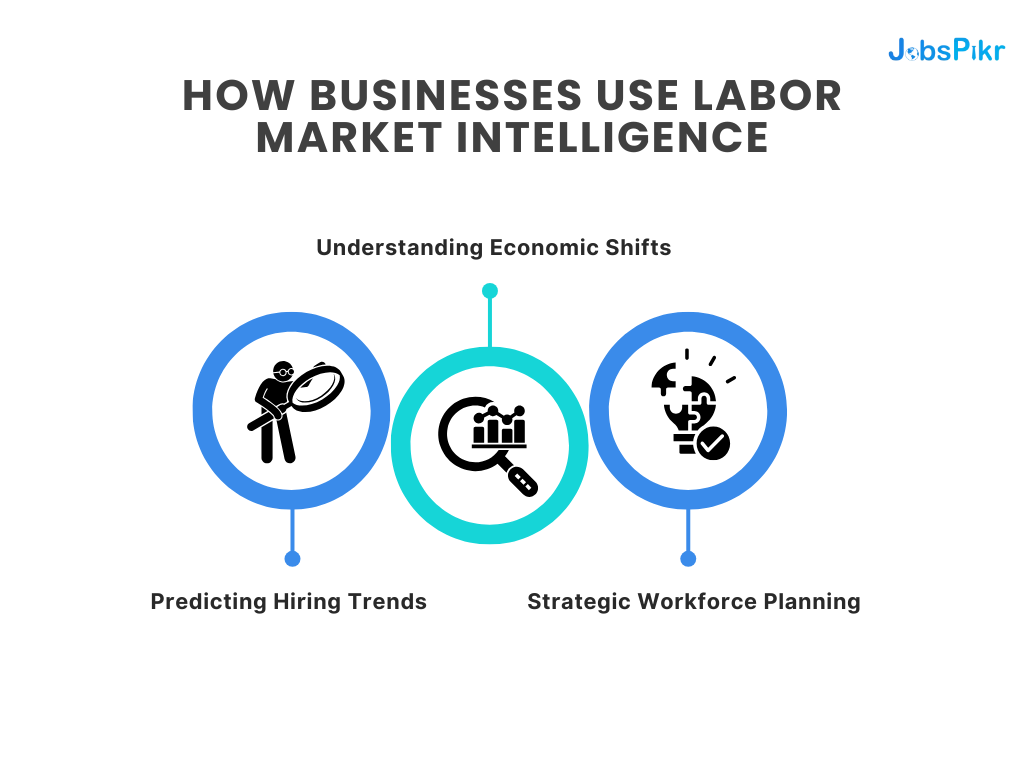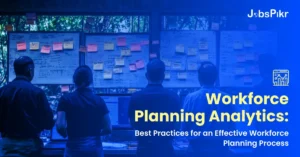The market is always changing, which makes it difficult for companies to acquire the right employees. New technologies, changes in workforce preferences, and economic changes make it harder for businesses to attract and retain skilled employees. This is where labor market intelligence becomes crucial.
Labor market intelligence provides valuable information to human resource managers and recruiters regarding the employment market and its trends, hiring styles, skills being requested, salaries that are expected, and more. With this type of information, companies can make hiring plans without any guesswork; in other words, they can accurately plan hiring activities based on data from the real world instead of using estimates.
Businesses can attain labor market intelligence using workforce intelligence software. These tools aid in the analysis of big data regarding the job market to make it easier for companies to be more proactive when it comes to recruitment, workforce planning, and talent strategy.
In this article, the workings of labor market intelligence and the reason why workforce intelligence software is becoming a must-have in modern hiring tactics are examined and explained in detail.
What is Labor Market Intelligence?
As its name suggests, Labor Market Intelligence encompasses the systematic study and gathering of data related to employment opportunities such as job vacancies, salary rates, and the corresponding availability of the labor force as well as the hiring trends within a certain industry.
This information gives organizations a better understanding of the available workforce and aids them in devising recruitment plans based on actual market scenarios instead of speculations.
Analyzing labor market information can help businesses pinpoint skill shortages, evaluate changing economic conditions that impact recruitment, and consider the level of staffing needed in the future.
A case in point is a firm in the IT industry that uses labor market intelligence to ascertain if there is an upsurge in demand for cloud computing specialists so that it can modify its recruitment plans appropriately.
How do Businesses Use Labor Market Intelligence for Workforce Planning?

Organizations have been using labor market intelligence to enhance the effectiveness of hiring and workforce planning. One of the most important aspects of this is predicting hiring needs. By reviewing employment advertisements, remuneration figures, and sector analysis, companies can establish the anticipated need for certain positions and take preemptive action regarding sourcing candidates.
Labor market intelligence also enables an organization to analyze economic trends that affect the existence of a skilled workforce. For example, during periods of economic recession, many businesses may find it relatively easier to attract job applicants, but during economic expansion, some sectors may more difficult to locate employees with the needed competencies. Employer’s ability to monitor the employment environment allows HR personnel to craft appropriate hiring policies.
Also, labor market data enables companies to optimize their recruitment strategies. Businesses may improve the effectiveness of their recruitment strategies by pinpointing areas where particular skill sets are more accessible or examining the hiring behaviors of rival firms.
The Role of Workforce Intelligence Software in HR Decision-Making
What is Workforce Intelligence Software?

Image Source: PAT
Workforce intelligence software is used by recruiters and human resource professionals to harness useful information from the vast and complex labor market data. These tools help clients objectify their hiring strategies by gathering and analyzing data from job vacancies, salary estimates, and other industry-related information in real-time.
Companies no longer need to depend solely on internal HR documents as intelligence software allows them to analyze the overall labor market for particular positions and their associated salary ranges, along with available skill sets. This information is crucial to develop effective hiring strategies to entice skilled employees.
How Workforce Intelligence Software Enhances Recruitment?
The most important advantage of workforce intelligence software is the ability to access up-to-the-minute information about trends in the job market. Recruiters can view how frequently different industry sectors are hiring and when they most require skilled employees, thus enabling them to make more intelligent hiring choices.
Its transformation into a skill demand analyzer is another benefit. As new industries emerge, some new skills are deemed more useful while others are not. Software that specializes in workforce intelligence empowers employers by emerging skills and modulating training or hiring plans accordingly.
For instance, people in business intelligence financial services can check with workforce intelligence tools if the demand for blockchain skills is available in the market and do something before it is too late.
Salary benchmarking is another field that adds value to the business through workforce intelligence software. Many organizations face difficulties with setting competitive salary ranges for certain positions and tend to base their offer on internal information, which often lacks external context.
Workforce intelligence software uses salary data from many databases and provides businesses with benchmark salaries for various positions enabling employers to select appropriate and competitive salaries. This helps companies get and keep the best-skilled employees.
Examples of Workforce Intelligence Software
Several tools help businesses gather and analyze labor market intelligence, including:
- JobsPikr – A data-driven workforce intelligence platform that provides job market insights, hiring trends, and salary benchmarks.
- LinkedIn Talent Insights – Offers analytics on workforce trends and talent availability.
- Burning Glass Technologies – Uses AI to analyze job postings and predict skill demands.
By using workforce intelligence software, HR teams can stay ahead of market trends and attract top talent more effectively.
Why Businesses Rely on Labor Market Intelligence for Growth?
• Identifying Emerging Job Roles and Industry Trends
Labor market intelligence can assist businesses in correcting job roles and following the development of certain domains before they turn into trends. There are also new skills that have not been available in the job market for a decade.
The market of employment keeps on changing with the advent of new technology. Businesses that monitor these developments can strategically change their employment policies to offer the required positions.
For instance, AI and Automation have increased demand for AI specialists and data scientists. These businesses have the opportunity to spot such trends well in time and establish appropriate training programs or focus their hiring campaigns on qualified personnel.
• Improving Hiring Efficiency with Predictive Workforce Analytics
The use of workforce intelligence allows for predictive hiring analytics which increase hiring accuracy. Instead of waiting for a hiring need to present itself, companies can use predictive analytics to anticipate recruitment needs.
This strategy enhances hiring efforts by anticipating which roles will be in demand long before the appropriate time. Engaging with potential candidates ahead of time creates a talent pool that businesses can easily recruit from, therefore shortening the time taken to fill job openings as well as minimizing costs.
• Gaining a Competitive Advantage in Workforce Planning
With the right data approach, businesses will have an upper hand with their competition. Businesses that monitor the labor market are able to optimize spending on recruitment, allocate funds appropriately, and lessen the chances of unsuccessful hires.
For instance, a business can decide to locate new offices in certain regions when they understand how available local talent is. The reverse is also true, and businesses can be kept current with industry trends through competitor hiring pattern analysis to aid in talent acquisition.
How JobsPikr’s Workforce Intelligence Software Helps Businesses?
For companies looking to gain a competitive edge in filling positions, wage setting, and tiered recruiting strategies, JobsPikr offers Intel through its workforce analytics solutions that monitor the labor market while providing real-time updates.
From the advanced analysis of the labor market, companies can gain valuable information on hiring patterns alongside demand for skills and salaries as per levels of education offered. This enables them to adjust their strategies for recruitment in line with market expectations for top talent, which ensures these businesses are never short of remarkable employees.
How Companies Leverage Labor Market Intelligence for Hiring?
A top-tier IT firm employed JobsPikr to surveil the market’s requirement for cloud computing specialists and revised its hiring strategy. With a focus on proactive skills, the company reduced the time taken to fill the positions and had top candidates onboarded before the competition.
In the same way, a retail chain used JobsPikr’s workforce intelligence data to improve seasonal hiring. Through historical analysis of hiring patterns, the company was able to refine its recruitment processes, leading to reduced attrition and higher productivity levels among employees.
These case studies show the extent to which JobsPikr shifts the paradigm of data-driven hiring, which forward-thinking businesses need to develop strategies for success.
Conclusion
No single company can afford to stick to the traditional ways of doing business in recruitment that are less effective now than ever. Companies that adopt labor market intelligence enjoy a unique positioning through sound hiring, workforce allocation, and proactive preparedness for shifts within the business environment.
Companies facing challenges around talent gaps, volatile remuneration rates, and changing job market conditions can now turn to workforce intelligence solutions like JobsPikr with assurance. Adopting data-centric workforce strategies should no longer be seen as optional for those seeking to succeed in attracting and retaining talent – particularly in the highly competitive dealing market.Explore our Labor Market Intelligence Solutions for more information on how JobsPikr can help redefine your hiring practices.



